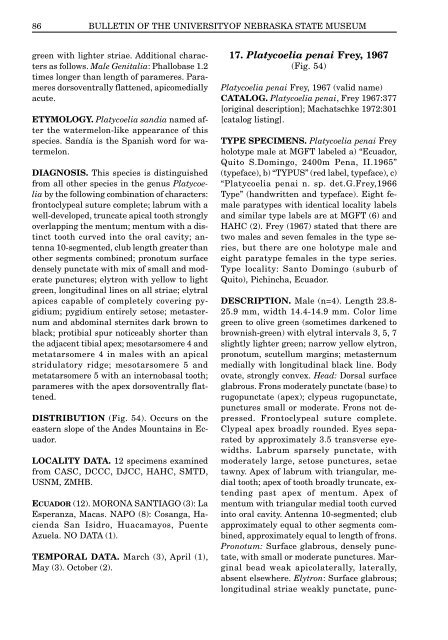Download full text (PDF 4.5 MB) - University of Nebraska State ...
Download full text (PDF 4.5 MB) - University of Nebraska State ...
Download full text (PDF 4.5 MB) - University of Nebraska State ...
You also want an ePaper? Increase the reach of your titles
YUMPU automatically turns print PDFs into web optimized ePapers that Google loves.
86 BULLETIN OF THE UNIVERSITYOF NEBRASKA STATE MUSEUM<br />
green with lighter striae. Additional characters<br />
as follows. Male Genitalia: Phallobase 1.2<br />
times longer than length <strong>of</strong> parameres. Parameres<br />
dorsoventrally flattened, apicomedially<br />
acute.<br />
ETYMOLOGY. Platycoelia sandia named after<br />
the watermelon-like appearance <strong>of</strong> this<br />
species. Sandía is the Spanish word for watermelon.<br />
DIAGNOSIS. This species is distinguished<br />
from all other species in the genus Platycoelia<br />
by the following combination <strong>of</strong> characters:<br />
frontoclypeal suture complete; labrum with a<br />
well-developed, truncate apical tooth strongly<br />
overlapping the mentum; mentum with a distinct<br />
tooth curved into the oral cavity; antenna<br />
10-segmented, club length greater than<br />
other segments combined; pronotum surface<br />
densely punctate with mix <strong>of</strong> small and moderate<br />
punctures; elytron with yellow to light<br />
green, longitudinal lines on all striae; elytral<br />
apices capable <strong>of</strong> completely covering pygidium;<br />
pygidium entirely setose; metasternum<br />
and abdominal sternites dark brown to<br />
black; protibial spur noticeably shorter than<br />
the adjacent tibial apex; mesotarsomere 4 and<br />
metatarsomere 4 in males with an apical<br />
stridulatory ridge; mesotarsomere 5 and<br />
metatarsomere 5 with an internobasal tooth;<br />
parameres with the apex dorsoventrally flattened.<br />
DISTRIBUTION (Fig. 54). Occurs on the<br />
eastern slope <strong>of</strong> the Andes Mountains in Ecuador.<br />
LOCALITY DATA. 12 specimens examined<br />
from CASC, DCCC, DJCC, HAHC, SMTD,<br />
USNM, ZMHB.<br />
ECUADOR (12). MORONA SANTIAGO (3): La<br />
Esperanza, Macas. NAPO (8): Cosanga, Hacienda<br />
San Isidro, Huacamayos, Puente<br />
Azuela. NO DATA (1).<br />
TEMPORAL DATA. March (3), April (1),<br />
May (3). October (2).<br />
17. Platycoelia penai Frey, 1967<br />
(Fig. 54)<br />
Platycoelia penai Frey, 1967 (valid name)<br />
CATALOG. Platycoelia penai, Frey 1967:377<br />
[original description]; Machatschke 1972:301<br />
[catalog listing].<br />
TYPE SPECIMENS. Platycoelia penai Frey<br />
holotype male at MGFT labeled a) “Ecuador,<br />
Quito S.Domingo, 2400m Pena, II.1965”<br />
(typeface), b) “TYPUS” (red label, typeface), c)<br />
“Platycoelia penai n. sp. det.G.Frey,1966<br />
Type” (handwritten and typeface). Eight female<br />
paratypes with identical locality labels<br />
and similar type labels are at MGFT (6) and<br />
HAHC (2). Frey (1967) stated that there are<br />
two males and seven females in the type series,<br />
but there are one holotype male and<br />
eight paratype females in the type series.<br />
Type locality: Santo Domingo (suburb <strong>of</strong><br />
Quito), Pichincha, Ecuador.<br />
DESCRIPTION. Male (n=4). Length 23.8-<br />
25.9 mm, width 14.4-14.9 mm. Color lime<br />
green to olive green (sometimes darkened to<br />
brownish-green) with elytral intervals 3, 5, 7<br />
slightly lighter green; narrow yellow elytron,<br />
pronotum, scutellum margins; metasternum<br />
medially with longitudinal black line. Body<br />
ovate, strongly convex. Head: Dorsal surface<br />
glabrous. Frons moderately punctate (base) to<br />
rugopunctate (apex); clypeus rugopunctate,<br />
punctures small or moderate. Frons not depressed.<br />
Frontoclypeal suture complete.<br />
Clypeal apex broadly rounded. Eyes separated<br />
by approximately 3.5 transverse eyewidths.<br />
Labrum sparsely punctate, with<br />
moderately large, setose punctures, setae<br />
tawny. Apex <strong>of</strong> labrum with triangular, medial<br />
tooth; apex <strong>of</strong> tooth broadly truncate, extending<br />
past apex <strong>of</strong> mentum. Apex <strong>of</strong><br />
mentum with triangular medial tooth curved<br />
into oral cavity. Antenna 10-segmented; club<br />
approximately equal to other segments combined,<br />
approximately equal to length <strong>of</strong> frons.<br />
Pronotum: Surface glabrous, densely punctate,<br />
with small or moderate punctures. Marginal<br />
bead weak apicolaterally, laterally,<br />
absent elsewhere. Elytron: Surface glabrous;<br />
longitudinal striae weakly punctate, punc-
















